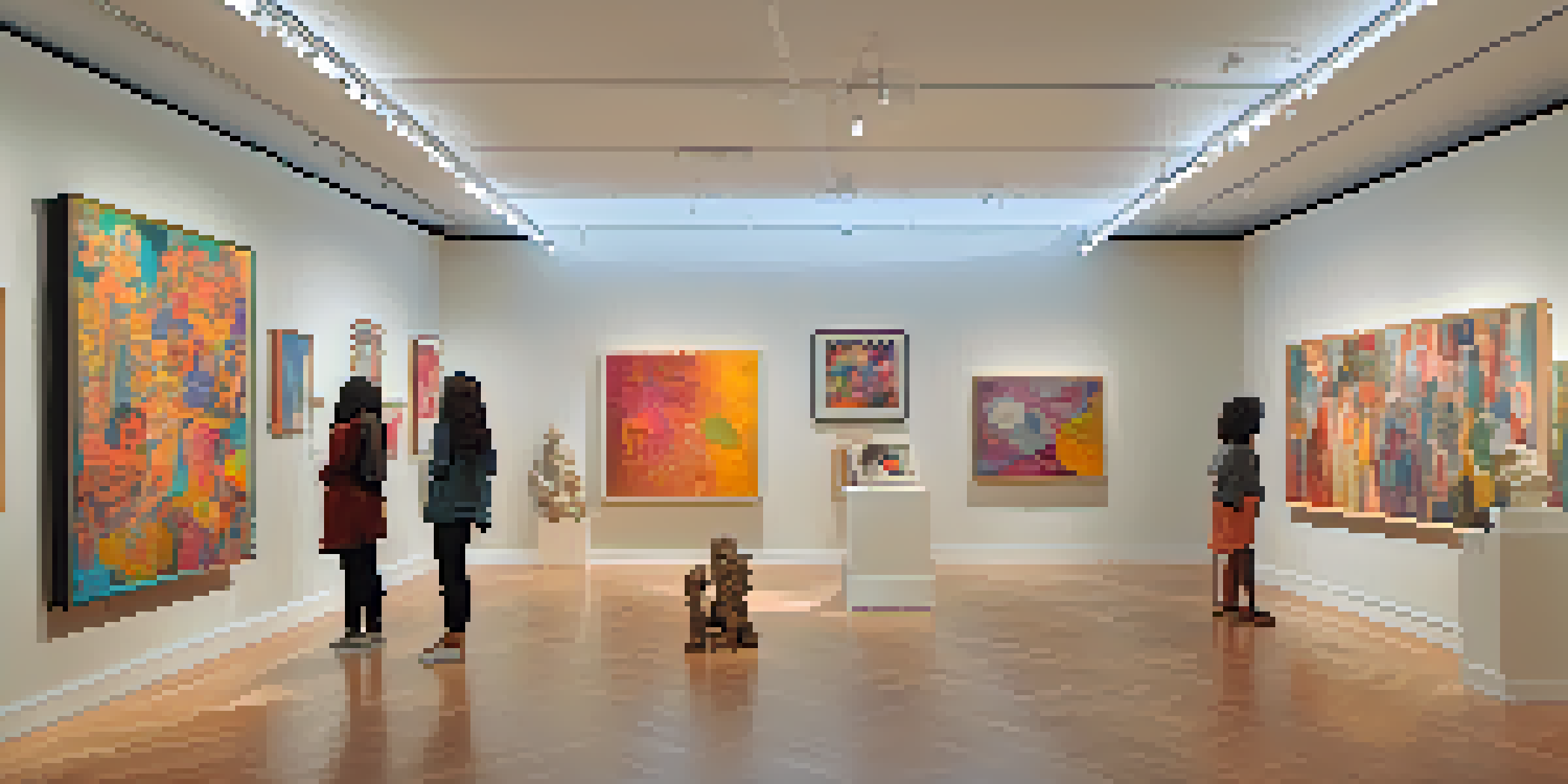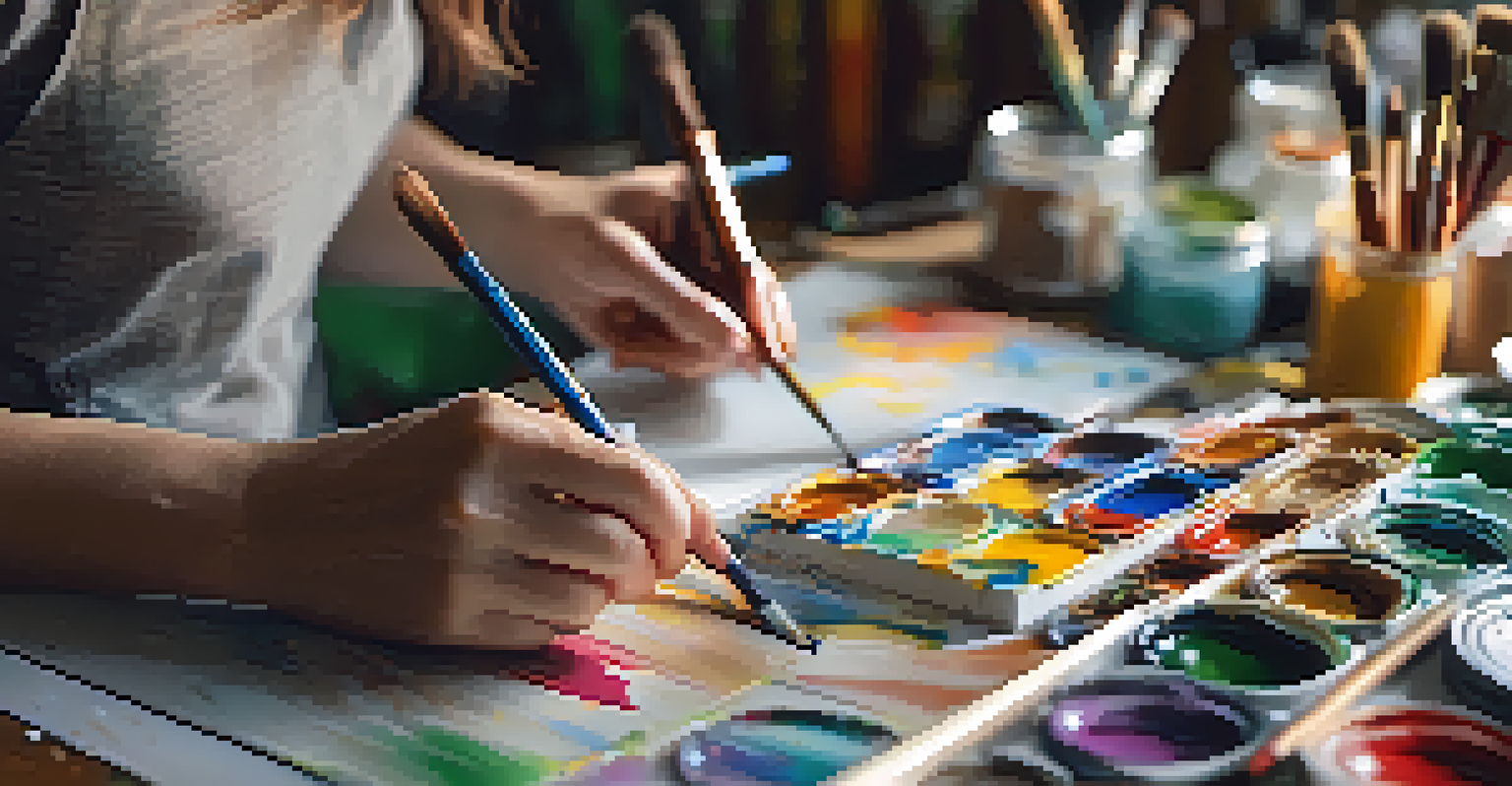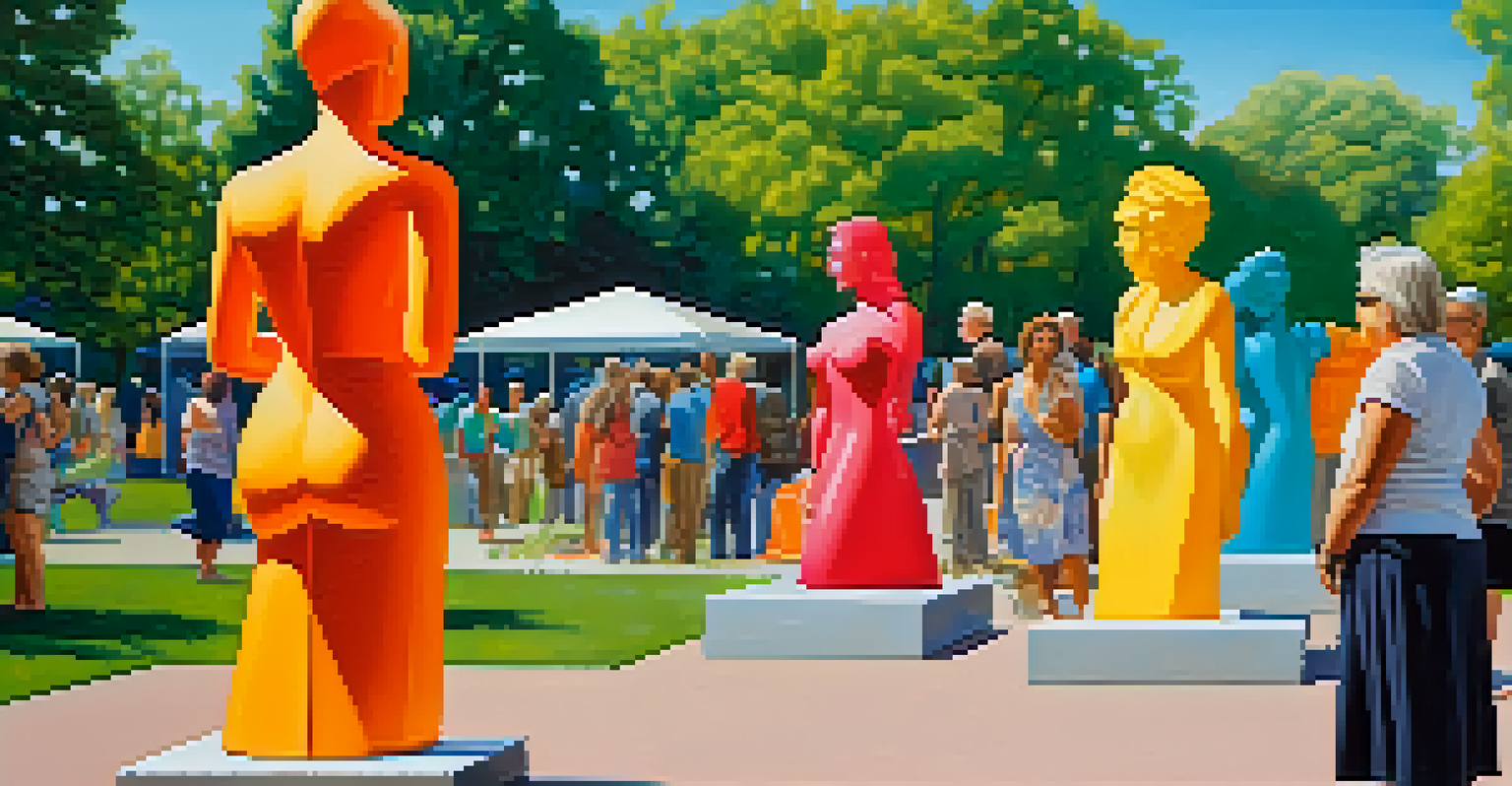The Unique Perspectives of Women in Contemporary Art

The Role of Women in Shaping Modern Art Narratives
Women have long been a driving force behind contemporary art, influencing narratives and themes that reflect their unique experiences. From the early 20th century to today, female artists have challenged societal norms, pushing boundaries of creativity and expression. Their contributions often highlight issues like identity, empowerment, and social justice, making their perspectives invaluable in the art world.
Women have been the backbone of the art world, breaking barriers and redefining the narrative.
Take, for example, the works of artists like Yayoi Kusama and Tracey Emin, who explore themes of mental health and personal trauma through their art. Kusama’s immersive installations invite viewers into her world of polka dots and infinity, while Emin’s raw, confessional pieces provoke deep emotional responses. Such works not only showcase their personal journeys but also resonate with broader audiences, opening up crucial conversations.
By examining the narratives crafted by women, we gain insight into the societal challenges they face, ultimately enriching the discourse within contemporary art. Their perspectives encourage a more inclusive understanding of art, where diverse voices contribute to a well-rounded narrative of our times.
Breaking Through Barriers: Women in the Art Market
Despite their significant contributions, women artists have historically faced barriers in the art market. Gender bias and lack of representation have often limited their visibility, leading to a disparity in recognition and sales compared to their male counterparts. This imbalance continues to challenge many female artists today, but recent movements are shifting the tide.

Organizations and initiatives focused on promoting female artists are emerging, creating platforms for their work and advocating for equitable representation. Art fairs specifically showcasing women-led galleries, such as 'We Are Here' in London, highlight the talent and innovation of female artists, providing them with the exposure they deserve. These efforts are crucial in transforming the art market landscape and ensuring women's voices are heard.
Women Redefining Modern Art
Female artists are crucial in shaping contemporary art narratives, often addressing themes of identity, empowerment, and social justice.
As more collectors and institutions recognize the value of including women artists in their collections, the market dynamics are slowly changing. This newfound attention not only empowers female artists but also enriches the art world, encouraging a diverse range of perspectives and stories.
The Impact of Feminism on Contemporary Art
Feminism has significantly influenced contemporary art, providing a framework through which women artists can express their experiences and challenge patriarchal narratives. From the feminist art movements of the 1970s to today, this influence has spurred the creation of powerful works that address themes of gender, power, and identity. Artists like Judy Chicago and Barbara Kruger have paved the way, using their art to confront societal norms.
Art is a powerful medium to challenge the status quo and provoke thought about our society.
Feminist approaches in art often encourage collaboration and community, as seen in projects like the 'The Dinner Party' by Judy Chicago, which celebrates women's history and contributions. These collective efforts create a sense of solidarity among women artists, fostering an environment where their voices can flourish. Through shared experiences and dialogue, these artists can challenge the status quo and redefine what art can be.
As contemporary art continues to evolve, the impact of feminism remains relevant, shaping the conversation around gender and representation. This ongoing dialogue not only empowers women artists but also invites audiences to reflect on their own perceptions of art and its role in society.
Exploring Intersectionality in Women's Art
Intersectionality plays a vital role in understanding the unique perspectives of women in contemporary art. This concept, which recognizes how various social identities intersect, allows artists to address multiple layers of oppression and privilege in their work. Women from diverse backgrounds bring forth their experiences, enriching the narrative within the art world.
Artists like Zanele Muholi and Frida Kahlo exemplify how intersectionality can inform artistic expression. Muholi's photography captures the lives of black LGBTQ+ individuals in South Africa, while Kahlo's self-portraits delve into her experiences as a woman and a person with disabilities. Such works highlight the complexities of identity and challenge viewers to consider the broader societal context surrounding these experiences.
Barriers in the Art Market
Despite significant contributions, women artists face historical barriers in visibility and recognition within the art market.
By embracing intersectionality, contemporary women artists create spaces for dialogue and understanding, inviting audiences to explore the multifaceted nature of identity. This deepens our appreciation for their art and encourages a more inclusive perspective on the issues they tackle.
The Rise of Digital Platforms for Female Artists
In the digital age, female artists are leveraging online platforms to showcase their work and connect with audiences worldwide. Social media, virtual galleries, and online marketplaces have become essential tools for women in art, allowing them to bypass traditional gatekeepers and find their own voices. This democratization of art access fosters a vibrant community, where emerging artists can thrive.
Platforms like Instagram and Pinterest enable artists to share their creative processes and engage directly with their audience. This not only helps promote their work but also builds a supportive network among female artists. Initiatives such as 'Art Girl Rising' harness the power of social media to amplify women's voices, creating awareness around the challenges they face in the industry.
As digital spaces continue to evolve, they offer unprecedented opportunities for female artists to redefine their narratives and reach new audiences. This shift is crucial for promoting gender equity in the art world and ensuring that women's perspectives remain visible and valued.
Challenging Stereotypes through Art
Women artists are increasingly using their work to challenge stereotypes and societal expectations. By confronting traditional notions of femininity, sexuality, and gender roles, these artists create thought-provoking pieces that provoke discussions around identity and representation. Their art often acts as a mirror, reflecting not only their experiences but also those of the wider community.
For instance, artists like Cindy Sherman and Kehinde Wiley subvert conventional portrayals of women and people of color in art history. Sherman’s conceptual photography critiques beauty standards and the roles women play in society, while Wiley’s portraits reimagine historical figures, placing people of color in positions of power. These powerful statements challenge viewers to reconsider their preconceived notions.
Digital Platforms Empower Artists
The rise of digital platforms allows female artists to connect with wider audiences and redefine their narratives, promoting gender equity in the art world.
By addressing stereotypes through their art, women artists contribute to a broader cultural shift that encourages inclusivity and diversity. This not only enriches the art world but also promotes a more nuanced understanding of the complexities of identity.
The Future of Women in Contemporary Art
As we look to the future, the role of women in contemporary art is poised for further evolution. With increasing visibility and recognition, more female artists are breaking through traditional barriers and making their mark on the global stage. The momentum gained from recent movements advocating for gender equity in art will likely continue to shape the landscape for years to come.
Educational programs and mentorship opportunities are also emerging to support aspiring female artists, helping to cultivate the next generation of creative voices. Initiatives that focus on inclusivity and diversity in art education ensure that women from all backgrounds have the resources they need to succeed. This foundation is crucial for fostering a vibrant and equitable art community.

Ultimately, the future of women in contemporary art holds great promise. As more diverse perspectives are embraced and valued, the art world will become richer and more representative of the society we live in. This ongoing journey towards equality will undoubtedly inspire future artists to explore their unique narratives and contribute to the evolving tapestry of contemporary art.